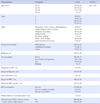Abstract
Purpose
This study was conducted to evaluate Korean version of the beliefs about Papanicolau (Pap) test and cervical cancer [CPC-28] in unmarried university students.
Methods
The Korean version of CPC-28 (K-CPC-28) was developed through forward-backward translation techniques. A reliability, confirmatory factor analysis and correlations coefficients were evaluated. Data were collected from 303 unmarried female students attending university using a questionnaire that included28 items of CPC, 5 items of susceptibility of cervicalcancer and 8 items of HPV knowledge.
Results
K-CPC-28 had reliable internal consistency with Cronbach's α=.74 of six subscales ranged from .66 to .80. Factor loadings of the 28 items of subscales ranged from .31 to .86. Six factors in this study explained 55% of the total variance. In convergent validity of the K-CPC-28, the subscales of K-CPC-28 were significantly correlated with susceptibility scale of cervical cancer and HPV knowledge scale.
Conclusion
K-CPC-28has satisfactory construct validity and reliability. It seems to be an acceptable tool to assess the attitudes toward cervical cancer prevention and Pap smear in unmarried women. This tool would be also applicable to screen the risk group in cervical cancer prevention and to identify its association with actual Pap test or cervical cancer prevention behaviors.
Figures and Tables
Table 3
Correlations among Six Factors, Susceptibility to Cervix Cancer and HPV Knowledge

Factor 1=need to have a Pap test; Factor 2=perceptions of cervix cancer (susceptibility and severity); Factor 3=cues to action to have a Pap test from family and neighbor; Factor 4=barriers to have a Pap test; Factor 5=awareness of Pap test; Factor 6=cues to action to have a Pap test from health professionals; HPV=human papillomavirus.
Summary Statement
▪ What is already known about this topic?
There is an increase in importance of the cervical cancer prevention knowledge for unmarried women. Papanicolau smear rate of the Korean women is relatively low. Health belief concepts have been partially used to assess cervicalcancer prevention behavior.
▪ What this paper adds?
Korean version of the beliefs about Papanicolau test and cervical cancer showed reliability and validity based.
▪ Implications for practice, education and/or policy
This tool would be useful to assess attitudes toward early cervical cancer prevention behavior, especially for young unmarried women.
References
1. American Cancer Society. Can cervical cancer be prevented? 2012. 03. 14. Retrieved August 23, 2012. from http://www.cancer.org/Cancer/CervicalCancer/DetailedGuide/cervicalcancer-prevention.
2. Clifford GM, Shin HR, Oh JK, Waterboer T, Ju YH, Vaccarella S, et al. Serologic response to oncogenic human papillomavirus types in male and female university students in Busan, South Korea. Cancer Epidemiol Biomarkers Prev. 2007. 16:1874–1879.

3. Denny-Smith T, Bairan A, Page MC. A survey of female nursing students' knowledge, health beliefs, perceptions of risk, and risk behaviors regarding human papillomavirus and cervical cancer. J Am Acad Nurse Pract. 2006. 18:62–69. http://dx.doi.org/10.1111/j.1745-7599.2006.00100.x.

4. Ingledue K, Cottrell R, Bernard A. College women's knowledge, perceptions, and preventive behaviors regarding human papillomavirus infection and cervical cancer. Am J Health Stud. 2004. 19:28–34.
5. Kim HW. Effects of prevention education on human papillomavirus linked to cervix cancer for unmarried female university students. J Korean Acad Nurs. 2009. 39:490–498. http://dx.doi.org/10.4040/jkan.2009.39.4.490.

6. Kim HW. Factors influencing mothers' acceptance of human papillomavirus vaccination to prevent cervical cancer in their daughters. Korean J Women Health Nurs. 2011a. 17:137–147. http://dx.doi.org/10.4069/kjwhn.2011.17.2.137.

7. Kim HW. Comparison of factors associated with intention to receive human papillomavirus vaccine between male and female undergraduate students. Korean J Women Health Nurs. 2011b. 17:415–425. http://dx.doi.org/10.4069/kjwhn.2011.17.4.415.

8. Kim HW. Knowledge about human papillomavirus (HPV), and health beliefs and intention to recommend HPV vaccination for girls and boys among Korean health teachers. Vaccine. 2012. 30:5327–5334. http://dx.doi.org/10.1016/j.vaccine.2012.06.040.

9. Kim HW, Ahn HY. Study on the knowledge of human papillomavirus in female university students. Korean J Women Health Nurs. 2007. 13:13–20.
10. Kim KS. AMOS 7.0 Analysis structural equation model. 2007. Seoul: Han Na Rae Publishing.
11. Lee EJ, Park JS. Knowledge about cervical cancer, health beliefs and human papillomavirus vaccination rate in female university students. J Korean Oncol Nurs. 2011. 11:65–73. http://dx.doi.org/10.5388/jkon.2011.11.1.65.

12. Lopez RV, Tanjasiri SP, McMahan S. College aged men's (18-24) knowledge and perceptions of human papillomavirus and cervical cancer. Californian J Health Promot. 2008. 6:143–155.
13. Lopez R, McMahan S. College women's perception and knowledge of human papillomavirus (HPV) and cervical cancer. Californian J Health Promot. 2007. 5:12–25.

14. National Cancer Information Center. Cervix cancer: Early screening. 2011. 01. 20. Retrieved August 15, 2012. from http://www.cancer.go.kr/ncic/cics_b/02/023/1253742_5876.html.
15. Rosenstock IM. The health belief model and preventive health behaviors. Health Educ Monogr. 1974. 2:354–386.
16. Statistics Korea. National cancer screening rates. 2012. 06. 15. Retrieved August, 28, 2012. from http://www.index.go.kr/egams/stts/jsp/potal/stts/PO_STTS_IdxMain.jsp?idx_cd=1440.
17. Urrutia MT. Development and testing of a questionnaire: beliefs about cervical cancer and Pap test in Chilean women. 2009. Retrieved April 4, 2012. Coral gables, FL: University of Miami;Doctoral dissertation. from http://scholarlyrepository.miami.edu/oa_dissertations/309.
18. WHO/ICO Information Centre on HPV and Cervical Cancer. Chile human papillomavirus and related cancers, fact sheet 2010. 2010a. 09. 15. Retrieved August 20, 2012. from http://apps.who.int/hpvcentre/statistics/dynamic/ico/country_pdf/CHL_FS.pdf?CFID=6613747&CFTOKEN=46889027.
19. WHO/ICO Information Centre on HPV and Cervical Cancer. Republic of Korea human papillomavirus and related cancers, fact sheet 2010. 2010b. 09. 15. Retrieved August 20, 2012. from http://apps.who.int/hpvcentre/statistics/dynamic/ico/country_pdf/KOR_FS.pdf?CFID=6613747&CFTOKEN=46889027.
20. Wikipedia. Beliefs. 2012. 06. 28. Retrieved August 28, 2012. from http://ko.wikipedia.org/wiki/%EB%AF%BF%EC%9D%8C.




 PDF
PDF ePub
ePub Citation
Citation Print
Print





 XML Download
XML Download